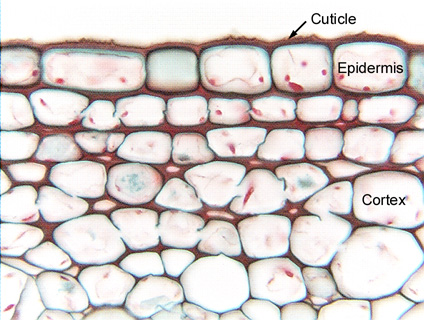 Fig.
10.2-1. Transverse
section of stem epidermis of cosmos (Cosmos). This is a rather
ordinary epidermis, a type you might see on many species. The cells
are box-shaped (neither columnar nor really flat), their walls are thin (these
are parenchyma cells) and the cuticle is a layer thick enough to be seen easily
but is not exceptionally thick. The cuticle is rough in a few places: perhaps if
viewed by SEM, the roughness would form a pattern, but in transverse section
like this, it merely appears irregular. These epidermal cells have protoplasm
(most epidermis cells remain alive after completing their morphogenesis).
Fig.
10.2-1. Transverse
section of stem epidermis of cosmos (Cosmos). This is a rather
ordinary epidermis, a type you might see on many species. The cells
are box-shaped (neither columnar nor really flat), their walls are thin (these
are parenchyma cells) and the cuticle is a layer thick enough to be seen easily
but is not exceptionally thick. The cuticle is rough in a few places: perhaps if
viewed by SEM, the roughness would form a pattern, but in transverse section
like this, it merely appears irregular. These epidermal cells have protoplasm
(most epidermis cells remain alive after completing their morphogenesis).
The cells below the epidermis are collenchyma.